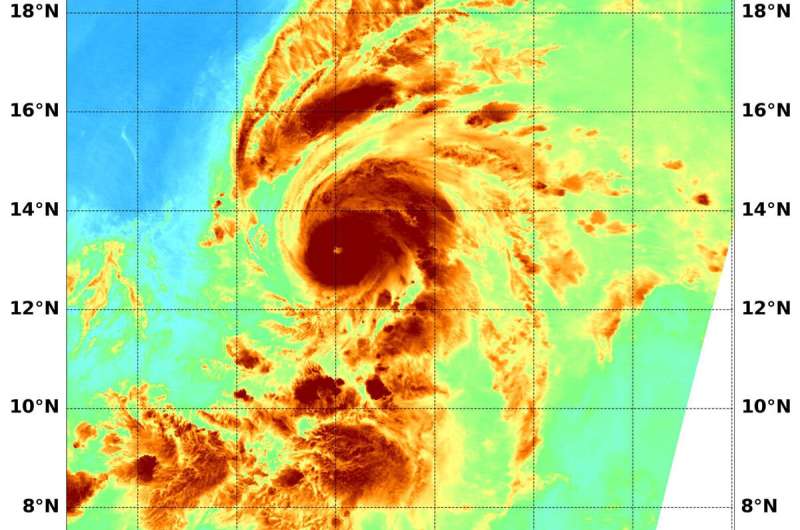NASA analyzes first central pacific ocean hurricane's water vapor

Hurricane Erick has become the first tropical cyclone to enter the Central Pacific Ocean during the 2019 Hurricane Season and Hawaii is keeping an eye on the storm. NASA's Aqua satellite is also keeping eyes on Erick, too, and analyzed the water vapor content within the storm.
NASA's Aqua satellite passed Hurricane Erick on July 30 at 7:20 a.m. EDT (1120 UTC) and the Moderate Resolution Imaging Spectroradiometer or MODIS instrument gathered water vapor content and temperature information. The MODIS image showed highest concentrations of water vapor and coldest cloud top temperatures were in a thick ring of storms around the newly developed eye and in a fragmented band of thunderstorms north-northwest of Erick's center.
MODIS data also showed coldest cloud top temperatures were as cold as or colder than minus 70 degrees Fahrenheit (minus 56.6 degrees Celsius) in those storms. Storms with cloud top temperatures that cold have the capability to produce heavy rainfall. The circular eye was indicated by warmer temperatures near minus 30 degrees Fahrenheit (minus 34.4 degrees Celsius). Those warmer temperatures, although still very cold, mean that there are high clouds covering the eye. High cirrus clouds covering the eye mean that it would not yet be seen on visible satellite imagery.
Water vapor analysis of tropical cyclones tells forecasters how much potential a storm has to develop. Water vapor releases latent heat as it condenses into liquid. That liquid becomes clouds and thunderstorms that make up a tropical cyclone. Temperature is important when trying to understand how strong storms can be. The higher the cloud tops, the colder and the stronger they are.
On Tuesday, July 30, 2019 at 5 a.m. EDT (0900 UTC or 11 p.m. HST on July 29), NOAA's National Hurricane Center (NHC) said the center of Hurricane Erick was located near latitude 13.1 degrees north and longitude 141.4 degrees west. About 1,015 miles (1,635 km) east-southeast of Hilo Hawaii. Erick is moving toward the west near 17 mph (28 kph). A west-northwest course at a slower forward speed is expected to begin on Tuesday and continue through Thursday.
Maximum sustained winds are near 80 mph (130 kph) with higher gusts. Hurricane-force winds extend outward up to 15 miles (30 km) from the center and tropical-storm-force winds extend outward up to 80 miles (130 km). The estimated minimum central pressure is 988 millibars.
NHC said additional strengthening is forecast through Wednesday. Weakening is expected starting by late Wednesday night or early Thursday morning.
Provided by NASA's Goddard Space Flight Center




















